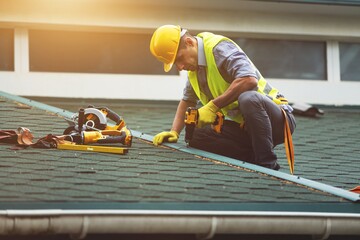When it comes to roof repair, there are several factors that you need to take into consideration. These include the type of shingles you have, the verge, and the soffits and soffit tiles you have. Asphalt shingles are some of the most affordable and popular roofing materials. They are also very easy to repair. However, you do need to take care of them to keep them looking and performing their best. Regular roof maintenance will catch small problems before they develop into serious ones. The average asphalt shingle roof should last 15 to 30 years, but some high-quality materials can have a life of over 50 years.
 When you do need to repair your roof, you should hire a local contractor to do the work. Professionals at www.tampabayroofing.com will know how to locate and fix deeper issues with your roof. Also, they can save you money by combining any additional repairs. Roof repair costs vary depending on the work needed and the materials used. You can expect to pay anywhere from a few hundred dollars to more than $1,500 for your project.
When you do need to repair your roof, you should hire a local contractor to do the work. Professionals at www.tampabayroofing.com will know how to locate and fix deeper issues with your roof. Also, they can save you money by combining any additional repairs. Roof repair costs vary depending on the work needed and the materials used. You can expect to pay anywhere from a few hundred dollars to more than $1,500 for your project.
Slate tiles for roof repair come in all shapes and sizes. Some roofing slates are manufactured to mimic the look of natural stone. Others are designed to last for a long time, even 100 years. They’re also made to be environmentally friendly. Slate tiles are a natural insulator that help your house stay cooler during the summer. Its density can stabilize the temperature of your structure, which can help reduce the risk of condensation and leaks. Metal and slate tiles for roof repair are durable and resistant to wind and hail damage. However, they can be susceptible to corrosion. So, check for loose fasteners and make sure you secure the underlayment. If you aren’t sure which material will work best for your roof, you can talk to a professional.
Soffits and fasciae are small parts of the exterior of your home. They protect the roofing system and keep weather from damaging it. These components also serve aesthetic purposes. While they are relatively unobtrusive, they can cause problems if they aren’t properly maintained. In addition, they’re often a gateway to pest infestations. Soffits and fasciae are usually made of wood or fiber cement. The former is lighter and easier to install. However, wood rots over time. Fiber cement can last 30 years or more when installed correctly.
If you have a problem with your soffits or fasciae, contact a professional for repair. They can replace broken or damaged pieces or seal off any cracks. This will help prevent future problems. When looking for a contractor, find out what materials they use. You might want to consider aluminum or vinyl. Vinyl is easy to install and won’t rot. It’s also available in different colors and textures.
If you have a roof with a dry verge, you may need to repair it. The traditional way of repairing the dry verge involves using mortar. It is a water resistant material and has a long lifespan. But it can become a source of problems if you do not fix it correctly. Before you can install a new dry verge, you need to remove the old one. Repointing the roof verge can take a few hours to a few days. This is because you need to remove all the tiles and fix them. Using a hammer and chisel, you can start by removing the old tiling batten. Be careful to not damage the tiled surface. After you have removed all the tiling, you can use a cold chisel to remove the mortar.
Tree limbs and branches collapsing onto a roof. When a tree limb or branch falls onto your roof, you need to take action to prevent further damage and to ensure your safety. Trees that are located close to your house can tip over into dangerous territory, and the weight of falling branches can put tremendous strain on your roof. Fortunately, you can keep your house and property safe by observing the best practices for removing tree limbs and branches. Besides, if you’re lucky, your insurance provider will cover the cost of repairing the damage. Depending on the type of limb or branch you’re dealing with, there are several steps you should take. Firstly, you should cut back the live limbs to at least fifteen feet away from your home. This will prevent small critters from making it into your attic.


